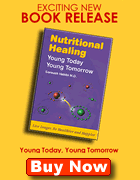 |
These include B1, B2, B3, B5, B6, B12, and folic acid, which has no number.
Some authorities consider the following as part of the B group: choline, inositol,
biotin, lipoic acid, para-aminobenzoic acid (PABA) and dimethylglycin. They
are called B group because they have a similar function and act as antioxidants'
co-factors.
Vitamin B1, Thiamin
Thiamin pyrophosphate is the active form of vitamin B1. Vitamin B1 is water-soluble
and essential in the energy cycle and utilisation of carbohydrates. It needs
folic acid for its absorption.
Source
Peas, lentils, soybeans, brown rice, peanuts, nuts, sunflower seeds, bread,
pork, and beef. White rice and white flour have substantially reduced the amount
of thiamin as a result of food processing.
Functions
- It is essential in energy production and glucose metabolism.
- It is a cofactor in more than 24 enzymes.
- It is converted into its active form in the brain and the liver.
- It is involved in neuro-transmission and acetylcholine synthesis.
- It improves memory due to acetylcholine production.
- It supports the antioxidant system.
Deficiency
Deficiency may lead to Beri-Beri, which is characterised by pins and needles,
and numbness in the limbs or so called peripheral neuropathy. This could be
accompanied by anorexia, lethargy and eventually heat failure and muscular degeneration.
In alcoholics thiamin deficiency may lead to Wernicke-Korsakoff syndrome associated
with memory loss, confusion, loss of balance, painful eyes, confabulation, irritability,
depression and even coma.
Treatment indications
These include heart failure due to cardiomyopathy, alcoholism, memory loss,
diabetes, MS (multiple sclerosis) and burning feet.
Laboratory
Thiamin levels could be measured in two ways:
- Red Blood Cell transketolase (TPP) enzyme reaction.
- Urine thiamin excretion test.
Dosage
RDA: 1-5 mg per day
EDR: 5-150 mg per day
On average 20-30 mg per day is required.
Vitamin B2, Riboflavin
Vitamin B2 is an excellent nutrient as it is involved in energy metabolism
and the natural antioxidant system, glutathione peroxidase. It works within
the cell.
Sources
Almonds, green leafy vegetables, avocados, mushrooms, eggs, cereal, meats and
yeast (Vegemite).
Functions
- It has a significant role in the metabolism of carbohydrate, protein and
fat.
- It maintains mucosal tissue, eye tissue and myelin sheath.
- It augments the effect of vitamin B6.
- It aids red blood cell production.
- It is important in antibody formation.
Deficiency
Deficiency may lead to cracked lips, inflamed and cracked mouth corners so-called
cheilitis, glossitis (red, sore and inflamed tongue) and geographic tongue.
It may cause seborrheic dermatitis with a red and scaly face. Eyes could be
affected causing blurred vision, conjunctivitis, cataract and tired eyes.
Treatment indications
It could be used in the above conditions. It is also indicated in Crohn's disease,
pregnancy and lactation, enhancement of immune system, child growth, alcoholism
and the elderly.
Toxicity
It is very safe and has not shown any toxicity to man.
Dosage
RDA: 1.7 mg per day
EDR: 10-35 mg per day
Vitamin B3
Vitamin B3, (niacin, nicotinic acid, nicotinamide or niacinamide)
Vitamin B3 is involved in the energy production, glucose and fat metabolism.
It is excellent for lowering cholesterol. It could be called "anti-cholesterol
vitamin".
It has been shown in a number of studies to help regression of coronary artery
disease.
Vitamin B3 has various forms (niacin, nicotinic acid, nicotinamide or niacinamide)
with similar activity.
Sources
Good sources are meat, fish, chicken, eggs, milk, almonds, sunflower seeds,
legumes, peanuts, whole grains and yeast. It can also be manufactured from tryptophan,
60 mg provides 1 mg of niacin.
Functions
- It lowers cholesterol by preventing the influx of FFA from the fat tissue.
- It triggers bile and stomach secretions.
- It is involved in hormone synthesis.
- It is involved in the metabolism of carbohydrates, proteins and fats to
produce energy.
Deficiency
Deficiency may cause nervousness, anxiety, memory loss and lethargy in the
early stages. If not treated after 8 weeks can result in pellagra, which is
characterised by Three-Ds: Dermatitis, Diarrhoea and Dementia. To treat pellagra
one needs to take nicotinamide 100 mg every 6 hours orally; and have a high
protein diet with tryptophan; also to add other vitamins especially B groups,
and to avoid alcohol. The result is dramatic, as the patient will show improvement
within 24 hours of treatment. 40
Treatment indications
In addition to the conditions mentioned above vitamin B3 is specifically indicated
for lowering cholesterol. It is best to take Nicotinamide which does not cause
flushing of the skin, at 100mg twice a day with food, and gradually increasing
to 500 mg twice a day over a period of 1-2 months. It has been shown to reduce
LDL cholesterol and elevate HDL cholesterol.
Side effects
Niacin may cause skin flushes so called "niacin flush". It may also
cause itchy skin. Taking one aspirin tablet half an hour before taking niacin
could prevent itchiness and flushing of the skin. In high doses it could cause
liver toxicity.
Dosage
RDA: 13-20 mg per day
EDR: 100-3000 mg per day, for general supplementation 40-50 mg per day will
suffice.
Vitamin B5, Pantothenic Acid
It is the "anti-stress" vitamin involved in energy production, antibodies,
neurotransmitters and adrenal hormones including cortisone. It helps the conversion
of choline to acetylcholine, which is a major neuro transmitter.
Sources
Good sources are avocado, whole grains, oranges, legumes, cereals, sweet potatoes,
beans, egg yolk, fish and poultry.
Treatment indications
- Neurological: stress, insomnia, depression and adrenal stress
- Skin and hair: eczema, wound healing, hair loss and varicose ulcers
- Respiratory: asthma, bronchitis and hay fever rhinitis
- Joints: rheumatoid arthritis and osteoarthritis
- Others: alcoholism and smoking
Side effects
Basically non-toxic in human
Dosage
RDA: 5-10 mg per day
EDR: 20-200mg per day with the average of 100 mg supplementation per day
Vitamin B6, Pyridoxine
Vitamin B6 is a super nutrient as it is involved in 60 enzyme reactions. It
is also involved in carbohydrate and protein metabolism, promotes haemoglobin
and red blood cell formation, and the manufacturing of neurotransmitters. It
is an essential part of protein metabolism and amino acids thus the higher the
protein intake the higher the need for vitamin B6.
Sources
Whole grains, avocados, bananas, cauliflower, nuts, walnuts, peanuts, seeds,
oatmeal, potatoes, egg yolk, meats, chicken and fish (tuna, salmon and mackerel).
Functions
- It improves tissue oxygenation.
- It enhances the immune system.
- It is involved in manufacturing EFAs (essential fatty acids).
- It is involved in the process of converting vitamin B3 from amino acid tryptophan.
- It facilitates production of neurotransmitters and hormones such as dopamine,
histamine, GABA (gamma amino butyric acid), noradrenaline and serotonin.
Deficiency
Deficiency may lead to skin problems such as seborrheic dermatitis on the face.
It may cause insomnia, irritability, anxiety, depression, mouth ulcers, cheilosis
(cracked lip and mouth corners), fluid retention, sore breasts and anaemia.
Treatment indications
The benefits of vitamin B6 supplementation are tremendous in medical practice
and interestingly are widely used by conventional doctors. For instance general
practitioners and surgeons prescribe it for PMT (premenstrual tension), breast
fibroadenosis (lumpy breasts), carpal tunnel syndrome and so on. Gynaecologists
administer it for morning sickness in pregnancy, period pain and sore breasts.
The indications are as follows:
- Heart: It reduces risk of CHD as it lowers homocysteine levels.
- Lung: It has been shown to dramatically improve asthmatic conditions.
- Kidney: It prevents recurrence of kidney stones in patients with a history
of calcium oxalate stones. It assists in lowering blood oxalate and urea levels.
- Intestine: Coeliac disease, Crohn's disease
- Nervous system: Parkinson's disease, memory loss, epilepsy, and muscular
disorders. Patients with depression are low in vitamin B6 and supplementation
with B6 improves this condition.
- Reproductive system: nausea from pregnancy, premenstrual fluid retention,
infertility, menopause and women who take the contraceptive pill.
- Pancreas: Diabetes and hypoglycaemia
- Bone and joints: It reduces the incidence of osteoporosis due to lowering
homocysteine level. It improves the pain in carpal tunnel syndrome.
Dosage
RDA: 1.5-2.6 mg per day
EDR: 10-150 mg per day. The average is 20-30 mg per day.
Toxicity
It is safe in recommended doses. Dosage above 1000 mg per day may cause sensory
ataxia and convulsion.
|
 |
Vitamin B12, Cobalamin, Cyanocobalamin
Vitamin B12 is the only water-soluble vitamin that is stored in the liver and
the stores last for 3-5 years. It is absorbed through the last part of the small
bowel called terminal ileum with the help of intrinsic factor, which is secreted
by the stomach mucosa.
Vitamin B12 is widely prescribed by a variety of doctors for various conditions,
which are well documented in medicine. It plays a major role in manufacturing
RNA (ribonucleic acid), DNA, RBC (red blood cells), and the formation of healthy
cells within the body and myelin sheath of the nerves.
Sources:
Good sources are mainly animal based foodstuffs such as meats, egg yolk, liver,
brain, kidney, and to a lesser extent fish and cheese. Vegetarians are usually
vitamin B12 deficient.
Bacteria in the bowel also produce Vitamin B12.
Functions
- It works with folic acid in maintaining maturation of red blood cells.
- It is involved in conversion of homocysteine to methionine.
- It assists in new cell formation.
- It keeps cell membranes healthy and strong.
- It is involved in maintaining healthy bone marrow.
Deficiency
Deficiency may result in pernicious anaemia due to intrinsic factor deficiency.
Patients with pernicious anaemia may present with lethargy, pallor, soft and
smooth tongue, pins and needles in fingers and toes and dementia. Treatment
is by B12 injection. First week 1000mcg twice imi (intra muscular injection),
then 1000mcg per week for 6 weeks and eventually 1000mcg every three months
for life.
Deficiency may also lead to spinal cord degeneration, growth retardation and
depression.
Treatment indications
- Reducing risk of CHD by lowering homocysteine level.
- B12 deficiency anaemia
- Depression
- Asthma, multiple sclerosis, Crohn's disease, ulcerative colitis
- Dementia by helping production of acetylcholine.
Dosage
RDA: 2 mcg
EDR: 5-1000 mcg. The average is 50-100 mcg per day.
Toxicity
B12 is extremely safe.
Folic Acid, Folacin, PMGA (Pteroyl-Mono-Glutamic Acid)
Folic acid is an inseparable part of B group as it works in synergy with B12
and has a similar function. It is important in RNA and DNA synthesis. It is
widely used in pregnancy to prevent neural tube defect like spina bifida. Folic
acid can be destroyed through cooking. It is absorbed from the first part of
the small intestine. It is stored in the liver for 3-6 months.
Sources
These consist of lentils, whole grains, cereals, broccoli, beans, oranges,
peas, cabbage, eggs and liver.
Treatment indications
- Prevention of cancers such as cervical cancer
- Prevention of spina bifida in newborns
- It helps skin disorders like acne, psoriasis and seborrheic dermatitis.
- It reduces the risk of CHD and osteoporosis by lowering homocysteine levels.
- It enhances memory and improves depression.
Dosage
RDA: 200 mcg
EDR: 1000-50,000 mcg. The average therapeutic dose is 1000 mcg per day.
Toxicity
There is no toxicity but it may mask B12 deficiency.
Biotin
Biotin belongs to B group vitamins essential in energy production as it affects
carbohydrate, fat and protein metabolism. It is vital for cell growth. It works
as a coenzyme in the production of fatty acids. Good sources are mushroom, cauliflower,
soybeans, nuts, beef, egg yolk and liver. The gut bacteria also produce it.
It is beneficial in lowering cholesterol, depression, dermatitis, and diabetes
by improving insulin sensitivity, insomnia and fatigue.
RDA is 30-100 mcg. EDR could vary from 50- 10,000 mcg per day with an average
of 50-100 mcg in normal individuals.
Choline
It is a valuable nutrient essential in maintaining a healthy liver and preventing
gallstones. It is also in acetylcholine production for memory enhancement especially
in Alzheimer patients; and it helps in the production of lecithin within the
liver from fatty acids and phosphoric acid.
Choline is found in lettuce, wheat germ, legumes, cauliflower, egg yolk and
liver.
It is indicated in hypertension, high cholesterol, Alzheimer's disease, gallstones,
glaucoma, MS and stroke.
RDA is not known. EDR is 100-6000mg per day with the average of 100-125 mg
daily.
Inositol
Inositol is similar to choline and biotin and important in lowering cholesterol.
It is also important in the function of the brain and the nerves, and survival
of cells in the bone marrow. It is an important part of the cell membrane.
Good sources are citrus fruits, legumes, whole grains, yeast, nuts and liver.
Inositol is also indicated in eczema, hair loss, the production of neurotransmitters,
anxiety, insomnia, hypertension and asthma.
RDA is not established yet. EDR is 100- 1000 mg per day with the average therapeutic
dose of 100-200 mg daily.
PABA, Para-Amino-Butyric Acid
PABA is a water-soluble vitamin within a vitamin as it is part of folic acid.
It stimulates certain intestinal bacteria to produce folic acid. It is well
known in skin care such as sunscreens as it protects against UVB (ultra violet
B).
It is found in wheat germ, liver, yeast and molasses.
It is indicated in restoring colour of hair, vitiligo, skin and intestinal
health.
DMG, Dimethylglycine
Although it is called vitamin B15 or pangamic acid, it is not a true vitamin.
It is found in rice, yeast, and pumpkin and sesame seeds. It is recommended
in premature aging, high cholesterol, hypertension and CHD. RDA is not yet established.
Doses of 30mg three time a day have been used with no toxicity.
Co-enzyme Q10
Co-enzyme Q10 has been documented to be deficient in patients with cancer.
Co Q10 is a potent antioxidant and not only enhances the immune system but also
inhibits cancer growth and in cases may cause regression. 5
Coenzyme Q10 is available in small amounts in a variety of foods such as meats,
fish, sardines, peanuts, soy and vegetable oils. Coenzyme Q10 is primarily made
from coenzyme Q within the cells especially the liver.
Co enzyme Q is found in a variety of foods from which the body makes CoQ10.
The body can also make Coenzyme Q10 from amino acid tyrosine for which the body
needs 8 vitamins and many trace elements.
Coenzyme Q10 could be regarded as part of the vitamin B group with powerful
antioxidant activity. It was discovered in 1957. It is called ubiquinone because
it is synthesised from coenzyme Q in every cell in the human body. It works
within the mitochondria to produce energy. It is crucial in the production of
ATP. Dr Peter Mitchell was awarded the Nobel Prize in 1978 for his work on Coenzyme
Q10 and the process of energy transfer within the mitochondria.
It has been shown that patients with heart disease are low in Coenzyme Q10.
Coenzyme Q10 has been freely used in Japan and Europe since 1980.
Coenzyme Q10 levels decline with age, thus supplementation is vital to maintain
youth levels.
Deficiency
Deficiency can occur due to the following:
- Aging
- Insufficient intake from our diet
- Reduced assimilation from our foods
- Excessive use by the body
- Exercise
- Medication such as class of "statins" which are cholesterol lowering
drugs
Benefits of Coenzyme Q10 supplementation
- It is used in heart failure and cardiomyopathy
- It has anti-cancer properties and it helps in the prevention and regression
of breast cancer
- It improves angina and mitral valve prolapse
- It helps patients with muscular dystrophy
- It is good for the enhancement of the immune system
- It is recommended for energy production and vitality
- It is a potent antioxidant and free radical scavenger
- It is good for repair of gingival (gum) disease
- It is recommended in diabetes and improves GTT (glucose tolerance test)
- In high doses could help patients with psoriasis.
- It has been reported that in high doses can initiate regression of coronary
artery disease if taken over period of 2-3 years. 27
- It lowers blood pressure by 10% or even more.
- It is highly beneficial in chronic fatigue syndrome (CFS).
Dosage
RDA not available
EDR is 15- 400 mg per day with the average dose of 30-60 mg daily.
For more detailed information and specific recommendations, please [click here] to become a member of DrHabibi.com
|
 |




